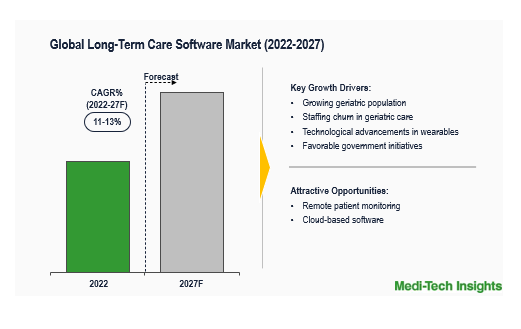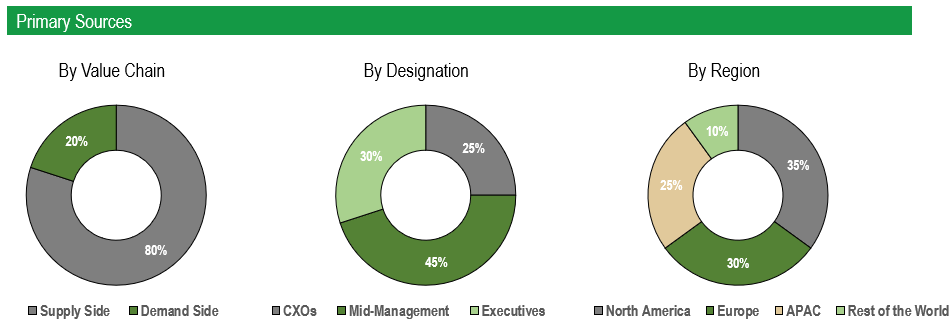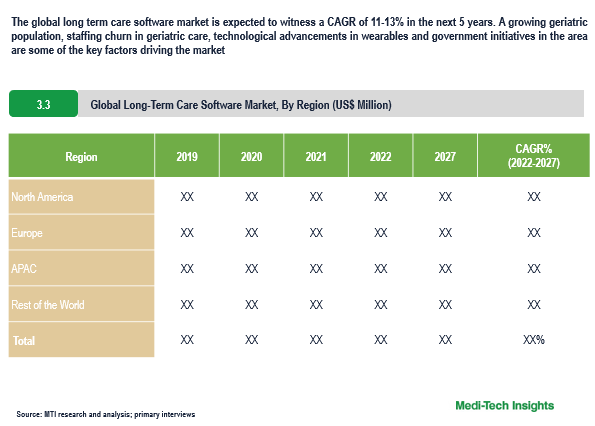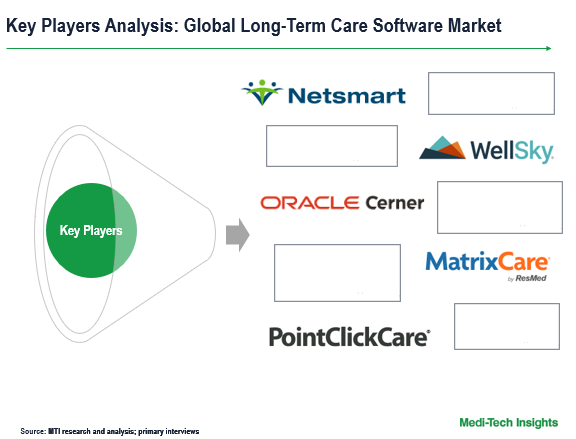Long-Term Care Software Market : Transforming Health & Social Care

The Global Long-Term Care Software Market is expected to witness a CAGR of 11-13% by 2027. Growing geriatric population, staffing churn in geriatric care, technological advancements in wearables, and government initiatives in the area are some of the key factors driving the market growth.
Long-term care software is used for the management and support of long-term healthcare facilities such as nursing homes, assisted living facilities, hospices, and independent living services such as home healthcare services. Long-term care software includes Clinical Software (EMR/EHR, E-prescribing, Electronic Medical Administration Records, Clinical Decision Support Systems) and Non-Clinical Software [Real-time locating systems (RTLS), Billing, Invoicing, & Scheduling, Payroll Management, among others]
Rising Aging Population drives the Demand for Long-Term Care Software Solutions
The WHO estimates that by 2030, approximately 1/6 of people in the world will be over 60 years old. The trend is expected to continue as developing countries begin to see increased life expectancies. In many developed countries populations already have significant elderly populations, for example, 29% of the population in Japan is over 65 and similar trends are being observed in multiple European countries. China is witnessing a similar problem where by 2050, ~40% of the population will be over retirement age, raising its dependency from 37% in 2015 to 70% in 2050. The UK has also seen dependency increase from 1/10 dependents to productive individuals at the introduction of the social state to 1/3 in the present day. These population imbalances are critical drivers for long term care software as lower proportions of the population are caring for more elderly patients.

Healthcare Staff Shortage likely to drive the demand for Long-Term Care Software Market
A second critical driver for the adoption of long-term care software is the high level of churn being witnessed in the healthcare sector. There is a current shortage of over 1 million workers in the EU, this trend is set to continue. Similar, churn from healthcare workers has been observed in the US. A lack of healthcare staff reduces the time patients can be seen. Long-term care software can reduce the time spend on individuals by healthcare professionals in a multitude of ways:
- Automating routine tasks: Long-term care software can automate routine tasks, such as medication management, scheduling, and billing. This can free up staff time and allow them to focus on higher-value tasks, such as patient care
- Improving communication and collaboration: Electronic health records (EHRs) allow multiple providers to access and update patient records in real-time, reducing the need for manual data entry and improving the accuracy of information. Central storing of patient data negates the need for staff to physically collect and move files around
- Enabling remote care: Remote care (telehealth or telemedicine) allows healthcare professionals to provide care and monitor patients from a distance. This is particularly useful in areas where there are shortages of healthcare professionals. These solutions reduce healthcare costs, remove barriers to healthcare and often improve patient outcomes. Examples of telehealth solutions include:
- Remote monitoring tools: Wearable devices and mobile apps collect patient data such as glucose levels, pulse and oximetry information and provide warnings for incidents such as patient falls
- Video medicine: Use of video assessments frees up healthcare professional time for low complexity or repeat problems in patients, which increases staff efficiency
- Providing decision support: Long-term care software can provide decision support tools that help healthcare professionals make informed decisions about patient care. For example, clinical decision support systems can provide alerts and recommendations based on patient data, helping to improve the quality of care and reduce the risk of errors.
Partnerships have emerged as a common strategy to expand their customer base and capabilities for Software Providers
Long-term care software companies are increasingly entering into partnerships with other software companies with differentiated capabilities to fortify their foothold in the long-term care software market.
For instance,
- In October 2022, PainChek (a leading pain assessment tool provider) signed marketplace partnership agreement with Point Click Care Inc, a leading Care Management Software System provider to nursing homes (long term aged care) in the USA and Canadian markets. PainChek’s integration into the PointClickCare platform will provide a seamless transition of the PainChek pain assessments into the Nursing Home’s resident information system for the USA and Canadian markets. PointClickCare will promote the PainChek integration capability to its nursing home clients in USA and Canada through its website, and regularly scheduled face to face client events.
North America is expected to hold a Larger Share in the Long-Term Care Software Market
The long-term care software market is growing strong in US. Baby boomers (individuals born between 1946 and 1964) are a generation defined by a period of strong population growth are now reaching an advanced age. As per estimates, in the US by 2030 all boomers will be over the age of 65 and will represent 21% of the population. According to the US Census Bureau, by 2034, the number of adults aged over 65 will reach 77 million while those under 18 will number 76.5 million. This swelling number of older adults is expected to drive demand for assisted living and in-home care and in turn demand for long-term care software.
Competitive Landscape Analysis: Long-Term Care Software Market
Some of the key players operating in the global long-term care software market are Netsmart Technologies, MatrixCare, Cerner Corporation (Acquired by Oracle), WellSky, and PointClickCare. These companies offer a wide range of software solutions, from electronic health records (EHR) to financial management and analytics tools, to meet the diverse needs of long-term care facilities.
Key Strategic Questions Addressed in this Report
- What is the market size & forecast of the long- term care software market?
- What are the historical, present, and forecasted market shares and growth rates of various segments and sub-segments of the long-term care software market?
- What are the key trends defining the long-term care software market?
- What are the major factors impacting the growth of the long-term care software market?
- What are the opportunities prevailing in the long-term care software market?
- Which region has the highest share in the global market? Which region is expected to witness the highest growth rate in the next 5 years?
- Who are the major players operating in the long-term care software market?
- What are the key strategies adopted by players operating in long-term care software market?
1. Research Methodology
1.1. Secondary Research
1.2. Primary Research
1.3. Market Estimation
1.4. Market Forecasting
2. Executive Summary
3. Market Overview
3.1. Market Dynamics
3.1.1. Drivers
3.1.2. Restraints
3.1.3. Opportunities
3.1.4. Market Trends
3.2. Industry Speaks
4. COVID-19 Impact on Long-Term Care Software Market
5. Global Long-Term Care Software - Size & Forecast (2019-2027), By Product
5.1. Clinical Software (EMR/EHR, E-prescribing, Electronic Medical Administration Records, Clinical Decision Support Systems)
5.2. Non-Clinical Software [Real-time locating systems (RTLS), Billing, Invoicing, & Scheduling, Payroll Management, among others]
6. Global Long-Term Care Software Market - Size & Forecast (2019-2027), By End User
6.1. Home Healthcare Agencies
6.2. Hospice Care Facilities
6.3. Nursing Homes & Assisted Living Facilities
7. Global Long-Term Care Software Market - Size & Forecast (2019-2027), By Region
7.1. North America (U.S. & Canada)
7.2. Europe
7.3. Asia-Pacific
7.4. Rest of the World (Includes Latin America, Middle East & Africa)
8. Competitive Landscape
8.1. Key Players and their Competitive Positioning
8.1.1. Market Share Analysis (2022)
8.1.2. Segment-wise Player Mapping
8.2. Key Strategies Assessment, By Player (2020-2022)
8.2.1. New Product & Service Launches
8.2.2. Partnerships, Agreements, & Collaborations
8.2.3. Mergers & Acquisitions
8.2.4. Geographic Expansion
9. Key Companies Scanned (Indicative List)
9.1. MatrixCare
9.2. WellSky
9.3. Cerner Corporation (Acquired by Oracle)
9.4. Netsmart Technologies
9.5. PointClickCare
9.6. Other companies
The study has been compiled based on extensive primary and secondary research.
Secondary Research (Indicative List)

Primary Research
To validate research findings (market size & forecasts, market segmentation, market dynamics, competitive landscape, key industry trends, etc.), extensive primary interviews were conducted with both supply and demand side stakeholders.
Supply Side Stakeholders:
- Senior Management Level: CEOs, Presidents, Vice-Presidents, Directors, Chief Technology Officers, Chief Commercial Officers
- Mid-Management Level: Product Managers, Sales Managers, Brand Managers, R&D Managers, Business Development Managers, Consultants
Demand Side Stakeholders:
- Stakeholders in Care Homes, Independent Living Facilities, Hospitals and hospices.
Breakdown of Primary Interviews

Market Size Estimation
Both ‘Top-Down and Bottom-Up Approaches’ were used to derive market size estimates and forecasts.
Data Triangulation
Research findings derived through secondary sources & internal analysis were validated with Primary Interviews, Internal Knowledge Repository, and Company’s Sales Data, and Global Health Data (IDF & WHO).




